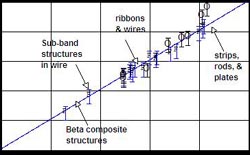
The mechanical properties of the monolithic glasses are under investigation. These include measurements of strength, ductility, toughness, and quasi static and dynamic deformation behavior. Collaborative research with faculty in the Applied Mechanics option (e.g. Prof. A.J. Rosakis) is part of this work. Studies of deformation and failure as a function of strain rate are done using high speed imaging and temperature measurement methods.

Shear band spacing versus sample thickness in bulk metallic glass
High-strain rate constitutive behavior of bulk metallic glass is also under study (Prof. G. Ravichandran). The understanding of high-strain-rate behavior of BMG is essential for modeling and analysis of numerous processes including high-speed machining, impact, penetration and shear localization. In this investigation, experiments are being performed to ascertain the strain hardening, strain rate hardening, and thermal softening over a wide range of strain, strain rate and temperature. Particular emphasis is placed on measuring the fraction of plastic work converted to heat as a function of strain and strain rate. Numerical modeling and material characterization are integral parts of this investigation.
Numerical modeling is also being applied to developing an understanding
of glass forming from a first-principles approach, using molecular dynamics
(Prof. W. Goddard) to both identify possible glass-forming alloy systems
and to model their phase diagrams. Viscous flow and processing is modeled
with finite elements. FEA modeling of dynamic processes enables researchers
to cross the bridge from theory to practice, and develop new net-shape
processing techniques.

Characterization techniques employed include x-ray diffraction and small angle x-ray scattering, neutron scattering (in collaboration with IPNS, at Argonne Nat. Lab), field ion microscopy, high resolution TEM, thermal analysis and calorimetry, and containerless processing by electromagnetic and electrostatic levitation of liquids. They participate in flight experiments on liquid alloys aboard the IML-2 and MSL-1 flights of the space shuttle.
Professor Johnson is currently heading a multi-university DoD project to develop structural amorphous metal for use in such diverse areas as aircraft, autos, sports products, and medical implants. The project includes collaborations with several companies (e.g. LiquidMetal Technologies, Boeing and General Motors).
Return to top
For Additional Information, contact
www@matsci.caltech.edu









